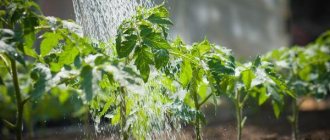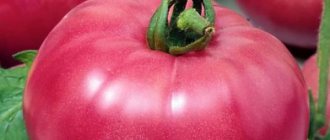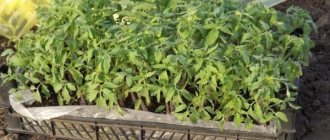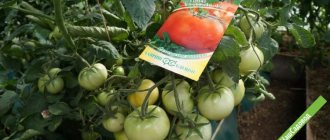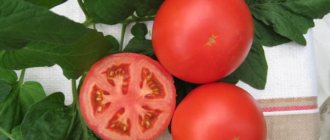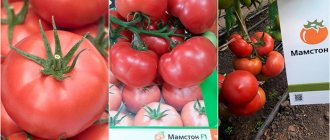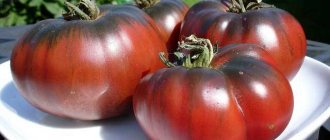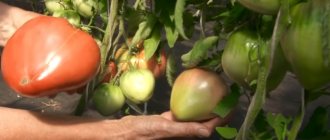Raspberry Empire F1 is an early ripening hybrid for salad purposes with tasty bright fruits. Like all hybrids, it is resistant to diseases and deviations from optimal growing conditions.
| Height | Landing location | Ripening time | Fruit color | Fruit size | Origin | Fruit shape |
| Tall | Greenhouse | Early ripening | Reds | Large | Hybrid | Heart-shaped |
Description and characteristics of the variety
The hybrid is new. It was registered in 2021, the originator is Oleg Dmitrievich Gerasimov. The Raspberry Empire tomato is sold, offering seeds at retail in packs of 10 pcs.
Raspberry Empire is an early ripening indeterminate hybrid that bears fruit 95-100 days after germination. The first corollas form above the 8th leaf, then the brushes develop through two or three leaves.
The fruits of the hybrid are notable - they are large (150 g), beautiful, similar to the Bull's Heart variety. Inside there are many chambers filled not with juice, but with pulp. There are very few seeds. The color of the peel and pulp is intense pink or crimson. There is no light spot with rough tissue on the stalk, so the entire fruit can be eaten.
Growing and care
Raspberry Empire tomatoes are grown using seedlings. Planting in the ground is carried out at the age of 70 days. Ideal conditions occur in late spring, so you can start sowing seeds in the third decade of March.
Seed preparation
Additional disinfectant treatment of seeds before sowing is not carried out. The manufacturer has already taken care of this.
Experienced farmers advise soaking the seeds for 12-15 hours to saturate them with oxygen. Then the water is drained and laid out on a damp cloth or paper towel.
The next step is to germinate the seeds. To do this, they are placed in a closed plastic container and placed in a warm place for two days. Why are such manipulations needed? The seeds are treated with special substances that prevent germination. Pre-soaking allows you to “wake up” the seed and increase germination. As soon as the seeds hatch, they are sown in the ground.
Growing seedlings
Pour damp soil into the seedling cups and make 2 cm depressions, throw the seeds into them and sprinkle with soil.
Keep the seedlings in a well-lit area. Water regularly, do not allow the soil to dry out. The first shoots will appear in seven days.
Don't forget about picking tomatoes. This will allow you to obtain seedlings with a strong root system. Start the process after the third leaf appears. Prepare fertile soil for planting seedlings:
- vermicompost – 3 parts;
- river sand - two parts;
- neutralized peat - one part;
- perlite - one part.
Pour a little mixture into 1 liter pots, remove the seedlings from the cups without shaking off the soil, and immerse them in the container. Fill with the remaining soil.
After 65-70 days from the moment of sowing, you will receive seedlings 20-25 cm high.
Monitoring seedlings will help to timely determine the lack of nutrients:
- Old leaves turn yellow, which means there is not enough nitrogen.
- Holes with yellow edges appeared on the leaves - there is not enough potassium.
- Phosphate deficiency is indicated by the death of old leaves.
- The leaves lighten and dark veins appear - add magnesium.
- Completely yellowed leaves indicate a lack of iron.
- New leaves are white or yellow - the plant needs nitrogen.
Growing rules
Hybrid Raspberry Empire is planted in loose, moist soil.
Acidity level – 7 pH. Before planting, it is recommended to disinfect the soil. The soil should not be treated with chemicals. Temperature – 12-15 °C. Plant no more than two stems per 1 square meter at intervals of 30-50 cm. Inspect the seedlings, remove dry yellowed leaves. The best time for planting is evening or cloudy day. The day before, fill the wells with a hot concentrated solution of potassium permanganate.
After planting, mulch the soil with straw, bark, wood chips or peat. Fertilize and water the plants on time if you want to achieve high yields.
The formation of the trunk begins in early summer. Excess shoots are broken off and those that appeared above the last flowering are left. The manipulation is performed every 10 days. First, healthy stepsons are removed, then sick ones. This speeds up ripening by two weeks.
Features of care
Raspberry Empire tomatoes do not tolerate waterlogging, especially if moisture gets on the leaves and stems. Therefore, watering is carried out strictly at the root. The optimal method in which the plant cannot be overwatered is a drip system. If you plan to water by hand, use a watering can without a sieve.
Reference. During flowering, water the tomatoes once a week, keeping the proportions - 12 l/1 m².
Raspberry Empire tomatoes are ideal for growing in a greenhouse. Such conditions make it possible to create a favorable microclimate, maintaining the air temperature at +24 °C and humidity at 60%. The stems are tied to the frame of the greenhouse.
Planting in open ground requires more intensive plant care:
- removing the lower leaves and stepsons to form a bush;
- tying to high supports;
- timely soil moisture.
Feeding schedule:
To get a rich harvest from the bush, five or six clusters of fruiting clusters with 2-3 leaves at the top are left on it. Feeding is carried out every 10 days. During the period of fruit ripening, the concentration of the solution is increased.
Features of growing the variety
The Giant Crimson tomato variety grows and bears fruit successfully in regions with a warm climate and a lot of sunny days, because this variety requires good lighting. Therefore, for cultivation in open ground, Giant is recommended in the following areas:
- Astrakhan;
- Belgorodskaya;
- Voronezh;
- Saratovskaya;
- in the Krasnodar region;
- in the republics of the Caucasus.
In more northern regions, it is better to grow raspberry Giant tomatoes in protected ground.
Sowing seedlings
Before seeds are sown in the ground, they should be prepared for planting:
- soak in a dark pink solution of potassium permanganate for 30-40 minutes;
- place the seeds in clean water for a day, change the water every 3-4 hours (so that the seeds do not suffocate);
- Before sowing, you can treat the seeds with some growth stimulant (for example, Zircon);
- dry the seeds on a paper napkin;
- Fill the seedling container with nutritious soil and compact it slightly;
- water the soil generously;
- spread lightly dried seeds over the surface of the soil at a distance of 2-2.5 cm;
then carefully sprinkle with slightly damp soil to a height of no more than 1.5 cm.
Place containers in plastic bags or cover with film. Once or twice a day, open the drawers slightly to ventilate and prevent the appearance of mold, moss, etc. Ventilate until shoots emerge.
Seeds should be sown 2.5-3 months before the intended planting of seedlings in the ground. In central Russia this is approximately the third ten days of February to the first ten days of March.
Growing seedlings
After the emergence of seedlings, the cover is removed from the containers. Now the main thing is to water the young shoots in time. While they are very tiny, they should be watered carefully: from a syringe, drop by drop, or with a spoon between the sprouts. Move the containers closer to the light.
Advice! Since plants do not have enough sunlight in early spring, it is useful to supplement the seedlings with special phytolamps so that they do not stretch out, but grow strong and stocky.
Each gardener decides whether to pick tomatoes or not. Some firmly adhere to the need for picking, others simply add a little soil between shoots. Both picking and bedding are done so that the plants form additional roots, which will ensure better further development of the bushes.
If you plan to plant tomatoes in open ground, the seedlings should begin to be hardened off:
- in cloudy warm weather it should be taken out into the open air, gradually increasing the time the seedlings stay outside;
- then you can increase the plants’ exposure to the sun (also starting from a very short period of time);
- At night, keep the containers with tomatoes in a warm place;
- It is also more favorable to plant bushes in warm, cloudy weather; if the weather is sunny, the plants should be shaded for the first time after planting so that they do not get sunburn;
- Giant seedlings should be planted at a distance of at least half a meter between the bushes, preferably 70 cm; better using the square-cluster method;
- when planting bushes, it is better to immediately install a support nearby, to which the plant must be tied in the future, so as not to disturb the root system of the tomatoes;
- When planting grown seedlings, they should be slightly buried when planting.
Clue! Since the Giant Raspberry is demanding of light, it is better to place the rows in the direction from north to south, which will provide the best illumination of the bushes and, as a result, improve the taste of the fruit and increase its sweetness.
Bush care
In the future, caring for tomato bushes consists of regular feeding, plant formation, tying, and pinching.
To prevent diseases and damage to tomatoes by pests, they should be inspected regularly.
It is necessary to water without allowing the top layer of soil to dry out, because... The giant is very sensitive to humidity levels. It is necessary to water with settled water between the rows, trying not to get it on the plants themselves. To ensure that moisture remains in the soil longer and there is no need to water frequently, it is good to mulch between the rows.
If tomatoes are grown in greenhouses, it is necessary to monitor the level of humidity, light and temperature; regularly ventilate the premises.
Clue! If, after planting seedlings in open ground, the weather forecast promises a drop in temperature so that the plants are not damaged by frost, late evening abundant watering successfully helps.
By following generally simple rules of agricultural technology, you can harvest a huge harvest of your favorite tomatoes.
The main thing is to give the plants the necessary attention and care. And then you can enjoy delicious sweet tomatoes all season long, some of which can be prepared in order to enjoy their magnificent taste in winter
Distinctive features of the hybrid
Among the early ripening varieties, Raspberry Empire is distinguished. When writing a description of a vegetable crop, it is noted that the variety has:
- the bush reaches a height of up to one and a half meters and above;
- fruiting occurs 95-110 days after the appearance of the first shoots;
- up to ten or more pink fruits without a green spot are formed on the clusters;
- the weight of heart-shaped tomatoes reaches 100 - 150 grams;
- high resistance of the hybrid to crown and root rot, brown spot;
- The tomato yield ranges from eighteen to twenty kilograms per square meter of planting.
Tomatoes of the Raspberry Empire variety are grown in open and closed ground. But the hybrid bears fruit better and lasts longer in greenhouses or greenhouses, under a film covering.
Hybrid information
The tomato was included in the State Register of the Russian Federation in 2021. It is suitable for growing in film-type greenhouses and open ground in the southern regions. The manufacturer is young but successful. The hybrid has managed to firmly occupy a leadership position - despite the fact that it only recently appeared on the market.
The Raspberry Empire tomato has a significant advantage over other varieties: it has high genetically determined protection against root and blossom end rot and brown spot.
Tomato Raspberry Empire: characteristics and description of the variety
This early ripening indeterminate tomato impresses with its performance.
| Indicators | Characteristic |
| Fruit weight | 150-200 g. |
| Form | Round, with a slightly pointed tip, reminiscent of a heart. |
| Fruit coloring | Bright crimson, without green inclusions near the stalk. |
| Leaves | Medium size, green. |
| Type of inflorescences | Intermediate. |
| Pulp | Medium density. |
| Taste qualities | The fruits are aromatic and sweet, with a slight sourness. |
| Skin | Thin and delicate, but dense. |
| Purpose | Tomatoes are suitable for pickling, pickling and making salads. |
| Bush height | Reaches one and a half to two meters. |
| Ripening period | 95-100 days. |
| Productivity | High, 20 kg/m2. |
| Harvesting | If tomatoes are harvested regularly, the harvest can be obtained until the end of October. |
| Fruiting | Long lasting. |
| Sustainability | To root and crown rot, brown spot. |
| Transportability | High. During transportation they do not crack and do not lose their presentation. |
| Planting Density | No more than 3-4 plants per 1 square meter. |
Reference. Indeterminate (tall) tomato hybrids have no restrictions on stem growth. The photo shows what a rich harvest can be obtained from one bush.
Advantages and disadvantages of tomatoes
Culture has many advantages:
- pleasant taste and refined aroma;
- high yield when grown in greenhouses and open ground;
- resistance to pests, which is formed during processing;
- thin and at the same time dense skin, which allows you to transport tomatoes over long distances;
- tender pulp;
- long-term storage;
- the possibility of year-round cultivation in greenhouses subject to certain conditions.
The cultivation process is complicated by some shortcomings of the hybrid:
- tall indeterminate bushes require constant care and formation;
- the need for constant fertilizing of the soil and abundant watering;
- instability to sub-zero temperatures does not make it possible to grow the hybrid in the northern regions in open areas;
- Fleshy fruits are not suitable for making tomato juice.
Advantages and disadvantages
Tomatoes of the Raspberry Empire variety have the following advantages.
- early ripeness and high yield of the hybrid;
- the fruits grow large and sweet;
- high immunity to diseases typical for the culture;
- The presence of a heated greenhouse and compliance with certain care conditions allows you to produce tomatoes until late autumn.
The tomato has some characteristics that make it difficult to cultivate or consume. For example:
- tall bushes require special attention;
- the variety places increased demands on soil nutrition and abundant moisture;
- The fruits are quite fleshy, so tomato juice cannot be obtained from them.
Tomato variety “Khlynovsky”: description, characteristics, sowing seedlings, fertilizing, yield, photos, videos and the most common tomato diseases
Resistance to diseases and pests
The variety is distinguished by its stable immunity to diseases.
Raspberry Empire tomatoes are marked F1, which characterizes this variety as a hybrid - it has immunity to negative environmental influences at the genetic level, including pest attacks, infection with fungal and infectious diseases.
():
There are no absolutely resistant varieties and hybrids to diseases and, especially, to pests. They have increased immunity. This means that in conditions of a strong spread of any disease, the number of affected plants of a given variety will not be 100%, but only, for example, 20-30%.
The bushes have weak resistance to such a common disease as late blight. However, with preventive treatment of the plant with special preparations, the tomatoes will remain healthy.
Growing Requirements
Many people choose hybrids bred by breeders for cultivation because they always produce high-quality fruits, their seed germination is 100%, and they have an excellent taste.
It is safer to grow the Raspberry Empire F1 tomato in a greenhouse. To do this, at the end of February or beginning of March, tomato seeds are planted in special containers or boxes. Caring for hybrid seedlings is ordinary. It consists of:
- glaze;
- feeding;
- picks.
65-day-old seedlings are planted in greenhouse conditions in late April - early May.
The elongated tomato shoots are placed in the holes obliquely, placing the stems on the ground, sprinkled with earth. If the greenhouse is low, then this method of planting tomatoes is also suitable.
Tall varieties must be tied to pegs, or better yet, to a horizontally stretched wire.
In order for the bushes to bear fruit better, no more than five to six fruit clusters are left on the plant. After this, you can pinch off the top of the main stem, leaving two or three leaves above the top cluster. This will help the fruits get enough nutrition.
It is advised to follow these rules for caring for Raspberry Empire tomatoes:
- Watering tomatoes abundantly should be infrequent. And to reduce evaporation from the soil, a layer of straw or peat two centimeters thick is laid around the tomato bushes.
- Every ten days, Raspberry Empire tomatoes need feeding. It is prepared from mullein diluted in a ratio of 1:5, adding ten grams of ammonium nitrate, fifty grams of superphosphate, fifteen grams of potassium salt to a bucket of solution. During the period of fruit ripening, the amount of potassium salt is increased to eighty grams, ammonium nitrate to thirty. A bucket of solution is added per square meter of tomato planting.
- When growing tomatoes, monitoring the air temperature in the greenhouse is mandatory. It should not rise above thirty degrees Celsius, otherwise the flowers will fall off due to the sterility of pollen.
- The optimal maintained humidity in the room for vegetables will be between fifty and seventy percent.
The hybrid tomato variety is characterized by good growth dynamics after planting in a greenhouse. Fruiting of tomatoes will increase if you form an indeterminate bush with one or two stems.
Advantages
Characteristics of the “Empire f1” tomato highlight many positive qualities. These include the following:
- high productivity;
- strong immunity, tolerates most diseases;
- tomatoes can be grown until the end of autumn in open ground and in a greenhouse all year round;
- rapid fruit ripening;
- possibility of long-term storage of vegetables;
- the fruits are not damaged during transportation;
- good taste and strong aroma.
Flaws
The variety has practically no bad sides, but many gardeners note the following:
- it is necessary to regularly form bushes to increase the yield;
- it is necessary to frequently moisten the soil and feed the plant;
- cultivation in open areas reduces yield by a third;
- It is almost impossible to make tomato juice from vegetables, since it turns out very thick.
Such shortcomings are relative, because they show the basic qualities of the plant. Therefore, in order to get a high yield, the gardener needs to pay a lot of attention to the plant.
Plant care rules
To get a high-quality and large harvest, you need to know how to care for tomatoes during flowering. Gardeners identify several basic rules.
- In order for the plant to produce a lot of fruit, it is left with 5-6 fruit clusters. Then the top of the base of the plant is pinched, but so that the upper clusters of 2-3 leaves remain. This procedure will help saturate the fruits with useful elements.
- Since this variety reaches a height of 1.5-2 m, it must be tied up.
- You should not water tomatoes very often. So that moisture can remain for a long time, a thick layer of peat or straw is poured around the plant.
- The plant must be fed every 10 days. Fertilizers are prepared independently; for this, take 1:5 manure, 1 bucket of solution mixed with 10g of ammonium nitrate, 50g of superphosphate and 15g of potassium salt. When the fruits begin to ripen, the amount of potassium salt should be increased to 80g, and ammonium nitrate to 30g. For 1 m2 of area you need to use a bucket of solution.
- During cultivation, it is necessary to monitor the air temperature and humidity.
It is also worth knowing that the amount of harvest depends on the formed bushes. Usually it is formed into 1-2 stems.
Possible diseases
Tomatoes of this variety have very strong immunity. They tolerate root and top rot well, and also do not suffer from brown spot.
SUPER YIELD TOMATO RASPBERRY EMPIRE!BEST TOMATOES OF THE SEASON!Raspberry Empire F1 A real tomato boom! Raspberry Empire in Chelyabinsk.
For the gardener's confidence, prevention can be carried out by spraying the plants with a light solution of potassium permanganate or garlic - this will protect the tomatoes from aphids.
Appearance of fruits
What do tomatoes of this hybrid variety look like? Externally, the fruits are round, slightly flattened, and bright pink-red in color. The tomatoes are heavy, over 150 grams. Tomatoes are perfect for eating fresh - the fruits are juicy, aromatic and tasty. The pulp itself is dense and consists of two or more chambers. Despite the fact that the tomato skin is thin, it does not crack or get damaged - the hybrid variety is suitable for canning as a whole.
In the photo of Raspberry Empire F1 tomatoes you can perfectly evaluate the appearance of the fruit - take a look at it in the images below.
Gardeners unanimously claim that this variety makes excellent tomato pastes and preserves. Vegetables are also good in any culinary dishes, fresh or after heat treatment. But the thick pulp does not allow you to get a homogeneous juice - it is too dense and more like a mousse.
Characteristics of tomato
Tomato Raspberry Empire f1 is an early ripening variety. The ripening period lasts 95-110 days. Productivity is always high; from every 1 m2 you can get 20 kg of excellent tomatoes. Tomatoes must be grown only in greenhouses; when grown in open ground, the amount of harvest is reduced by a third.
The Raspberry Empire variety is a hybrid, so it is impossible to collect the seeds yourself.
Description of the plant
Description of the plant - a tall bush, reaches within 1.5 m. The leaves are green, fibrous.
Raspberry Empire tomatoes grow well in the northern regions of the country. They tolerate drought and cold well.
Description of the fruit
The weight of one fruit is 100-150 g. The Raspberry Empire tomato variety has round fruits of a crimson color. The skin is thin, but quite strong, it can protect tomatoes from cracking. The pulp of tomatoes is dense and contains several chambers. Tomatoes have excellent taste and bright aroma.
Feedback from partner gardeners is only positive; they say that the tomatoes are very tasty and aromatic. You can make good thick pasta, salads and many other dishes from them. The vegetable is also used for canning for the winter. It is not recommended to prepare juice from this variety, as it turns out very thick.
Tomatoes have a large number of vitamins and minerals, as well as fiber and acids. Therefore, Raspberry Empire tomatoes are not only tasty, but also very healthy.
Advantages and disadvantages
- The advantages of this tomato variety are obvious:
- excellent taste and aroma;
- early maturation;
- high productivity;
- resistance to brown spot, root and crown rot;
- possibility of preserving whole fruits.
- The disadvantages of a hybrid are:
- the need for constant formation and removal of stepchildren;
- demands on soil nutrition and watering;
- not for northern regions in open ground;
- not for juice.
Basic rules for planting tomatoes
Tomatoes Raspberry Empire f1 can be grown both in the air and in a greenhouse. To get a high yield, it is better to cultivate in a greenhouse or under a film cover.
To get a good harvest, follow the recommendations
Tomatoes ripen at the same time, so partner gardeners will be able to harvest a high-quality harvest without any problems. But in order for the harvest to really ripen on time and be tasty, you need to know how to prepare planting material and follow the planting rules.
Soil and seed preparation
A few weeks before planting, the partners prepare the seedlings. They should be healthy, have a normal appearance, and their leaves should be rich green. The height of the plant should be 20-25 cm.
In order for the plant to grow and develop normally, it must be fed on time. Since vegetables love moist soil, it is worth taking care of this, so you need to water regularly. To retain the right amount of moisture in the ground, you can apply mulch. It is poured under each bush in a circle.
Planting seedlings
Tomatoes of this f1 variety need to be grown using seedlings. You need to know the sowing time and take into account the climate of the area. The seedling must be 65 days old; it is at this age that planting in the ground begins. The planting period is the end of May, so the seeds begin to be sown in mid-March.
The optimal temperature for tomato growth is 23-250C, so it is worth monitoring the indicators in the greenhouse. Air humidity should be 50-70%. Such growing conditions prevent diseases from attacking tomatoes and help to set a large number of ovaries. When the seedlings have grown, they are planted in holes at an angle so that the stems lie on the ground and are covered with it.
Stem formation
To increase yield, tomatoes are formed into stems; they begin to do this in early June. Unnecessary shoots are cut off and a few are left above the last flowering. This process is carried out over 10-12 days. If the gardener leaves the main stem, then all the stepsons are completely removed. This procedure will speed up the ripening process by several weeks.
To ensure that the procedure is painless for the plant, the stepsons begin to be cut off when their length is 3-5 cm. Healthy stems are cut off first, and only then the diseased ones. This sequence will prevent diseases from spreading, since the virus spreads through the juice of tomatoes when pruning.
Planting and watering
When transferring seedlings, remember a few simple but important rules. The soil for planting should be warmed up - 12-15°C. To achieve this, cover the ground with black plastic film in advance.
Plant no more than 3 pieces and no more than 2 stems per 1 m². Because darkening of plants should not occur. Otherwise, the fruits will delay their ripening.
Do not immerse seedlings to deep depths; this may affect the growth of the tomato due to the structural features of the root. Carefully inspect the sprout, remove diseased yellowed leaves. Set the distance between seedlings to 30-50 centimeters. Planting is done in the evening or on a cloudy day in pre-moistened soil. To disinfect the holes the day before, you can spill them with a strong, hot solution of potassium permanganate.
Tomatoes really don’t like it when water gets on their stems and leaves, so they are always watered only at the root. Therefore, the best device for this type of care is a watering can without a sieve. Do not overuse irrigation too often. During flowering, water the tomatoes once every 7 days in approximate proportions of 12 liters of water per 1 m².
Sowing seeds for seedlings
To grow seedlings, you need high-quality seeds from a trusted supplier.
Optimal timing
Seedlings are prepared 60–65 days before transplanting into a greenhouse or open bed. The exact sowing time depends on the region and the ability to use additional lighting. The average date is mid-March.
Soil mixture
A large selection of soil mixtures for growing seedlings is available in shopping and garden centers. If you decide to prepare the soil yourself, it is necessary to carry out preliminary disinfection of the soil collected in the garden or other place.
There are several ways to destroy possible sources of diseases and pests:
- pour in a solution of potassium permanganate;
- expose to water vapor for 7–8 minutes followed by cooling;
- leave for 30 minutes in the oven at +70°C–+90°C;
- freeze and let thaw (repeat the procedure 2-3 times). The temperature in the cold should be –15°C––20°C, and the ground should thaw within 3–5 days.
- a teaspoon of urea;
- a tablespoon of potassium sulfate;
- three tablespoons of superphosphate.
Growing container
The optimal container for seedlings is ready-made plastic or peat containers with a transparent lid that will not touch the ground. Such a shelter will provide a greenhouse microclimate favorable for seed germination. If there is no lid, you can use glass or film.
Seed preparation
The first rejection consists of inspecting the seed and removing damaged seeds. Further:
- soak in a weak solution of potassium permanganate. Seeds that have sunk to the bottom are tested for germination;
- Soak selected seeds in “Epin-extra”, “Zircon” or “Kornevin”, which are modern growth stimulants.
Description and characteristics of the Lazy currant variety, planting and care
Sowing seeds
Sowing is carried out according to the standard scheme to a depth of 1–1.5 cm. The first watering with warm water is done from a spray bottle to avoid washing out the seed with a stream of water. Then you need to close the container with a lid and put it in a warm place.
The tomato germinates in 7-10 days. Until this point, the lid is opened only to spray dried soil. If condensation appears on the walls, it must be removed.
Seedling care
Sprouted tomatoes are placed in a well-lit place at a temperature of +15°C–+16°C, and then it is raised again to room temperature.
For healthy seedlings it is necessary to provide:
- careful watering by spraying warm water under the roots;
- no waterlogging;
- good lighting.
Fertilizing of seedlings is carried out in case of obvious lack of nutrients, which can be judged by the appearance of the plants:
- lack of potassium is manifested by leaf wrinkling;
- lack of phosphorus is visible by purple veins on the stems and lower parts of the leaves;
- yellowing and falling of the lower leaves is a signal of nitrogen deficiency.
Hardening of seedlings
To prevent the seedlings from being subjected to too much stress in their permanent location, they begin to prepare them for new conditions in advance. The hardening process begins 7–10 days before transplantation.
The plants are taken out into the open air, first for half an hour, and then the time is increased to full daylight. It is necessary to monitor the temperature: the minimum mark for tomatoes is +8°C. The place chosen for the procedure should not be in a draft and should not be illuminated by direct rays of the sun. For hardening at home, you can use a balcony with open windows.
Diseases and pests
The hybrid is susceptible to late blight, which can be combated with folk remedies and fungicides.
An excess of nitrogen in the soil and uncontrolled watering lead to a decrease in yield. The crop is susceptible to attack by various insects: aphids, mole crickets, chafer beetles (larvae), midges and worms. Traps and treatment with a solution of potassium permanganate or garlic help control pests.
Garlic infusion recipe:
- pass the peeled garlic through a press, add water in equal proportions;
- leave to infuse for two weeks;
- Before spraying, strain and add water in a ratio of 1:5.
Farmer reviews
Despite the fact that the Raspberry Empire hybrid appeared relatively recently, many amateur gardeners and professional farmers have managed to appreciate it.
Maria, Krasnodar: “I first tried to plant the Raspberry Empire last year. I saw branches covered with fruits in my neighbor’s summer cottage and was inspired. I liked the hybrid. It is unpretentious in care; a large harvest was collected from each bush until late autumn. The tomatoes were eaten fresh, pickled, salted and distributed to relatives.”
Vasily, Liski: “I’ve been growing the hybrid for the second year at the dacha in a greenhouse, I’m very pleased. The yield is high, the tomatoes are tasty and fragrant, and last a long time. The main task is to feed on time. Then the branches will burst with grapes. I was convinced of this from my own experience.”
Olga, Chekhov: “Last year my husband and I decided to try to grow a new variety of tomatoes. After reading the reviews, we chose the hybrid Raspberry Empire instead of the variety and were not disappointed. The plant is resistant to rot and spots do not appear on the fruits. They were treated for late blight and fed in a timely manner. The result was impressive! There were so many tomatoes that they didn’t know what to do with them. We prepared salads, appetizers and wrapped them up for the winter.”
How to care
Caring for the “raspberry empire” hybrid consists of regular watering, bush formation and fertilizing. In a greenhouse, tomatoes grow well at +24°C and 60% humidity.
Watering
Watering is carried out as the soil dries with settled water, trying not to get on the foliage. To reduce the rate of soil drying, mulching with hay and other mixtures is used. Drip irrigation is recommended.
Feeding
For a high yield, it is necessary to fertilize the bushes every 10 days.
A proven fertilizer recipe consists of the following ingredients:
- a bucket of solution (1 part mullein to 5 parts water);
- 10 g ammonium nitrate;
- 50 g superphosphate;
- 15 g potassium salt.
Stepsoning
The bushes need constant pinching, that is, the removal of new shoots in the internodes of the leaves. Breaking out shoots should be done as early as possible and in sunny weather to avoid infection of the wound with diseases. The bush is formed into 1–2 stems.
Soil care
Plants need nutritious and loose soil, as well as the absence of weeds.
The best way to solve these problems is to completely mulch the bushes. Can be used:
- dry hay;
- a mixture of sawdust and compost;
- humus.
Tying up a bush
Tall bushes with heavy tassels need reliable support and tying, since the stem can easily break under the weight of the fruit. The trellis is built in open ground, and sometimes the frame of the structure itself is used in a greenhouse. For tying, special materials or soft tape are used so as not to damage the stem.
Preventative treatment
This hybrid is resistant to most diseases, except late blight. To prevent the disease, it is necessary to treat with branded copper preparations or iodine solutions.
Video: Tomato variety “Raspberry Empire”, yield
The “raspberry empire” hybrid has good economic prospects, especially in closed ground conditions. Plants respond to proper care with high yields.
Late blight
To prevent infection, preventive measures must be taken. According to the advice of experienced gardeners, it is necessary to spray the bushes with an infusion of garlic or a kefir solution. You can also fight fungus using a milk-iodide solution; iodine helps destroy microbes, and the fermented milk environment will prevent the fungal virus from spreading.
The “Pink Fleshy” variety, thanks to minimal care and rapid ripening, will allow you to enjoy juicy tomatoes before the end of summer.
Reviews from experienced gardeners warn that late blight is especially dangerous for pink and fleshy tomatoes. Without prevention and prevention of the disease, the fungus can destroy plants and fruits in a couple of weeks. It spreads quickly, especially in rainy weather.
With a minimum of care and due to their early ripening, “Pink Fleshy” tomatoes will allow you to enjoy juicy pulp even before the end of summer.
tomato Rosemary - description and characteristics of the variety
Harvest volume and application
Hybrid Raspberry Empire – early ripening. The first harvest appears three months after sowing the seeds. The fruits ripen in clusters. From one bush you can collect up to 5 kg. In greenhouse conditions, the yield is high and amounts to 20 kg/1 m2. On open ground - 30% less.
Tomatoes actively bear fruit in the summer. By autumn, the yield decreases, and the fruits are harvested up to three times a week.
The appearance of pink ripeness on the fruits signals the need for harvesting. It is not recommended to wait until full maturity. This increases the fruitfulness of the cluster; the fruits form small and lose their filling.
Thanks to their fleshy structure, thin skin and wonderful taste, Pink Empire tomatoes are delicious fresh or canned. When cooked, the skin does not crack; the size of the fruit allows you to marinate and salt them whole in jars.
